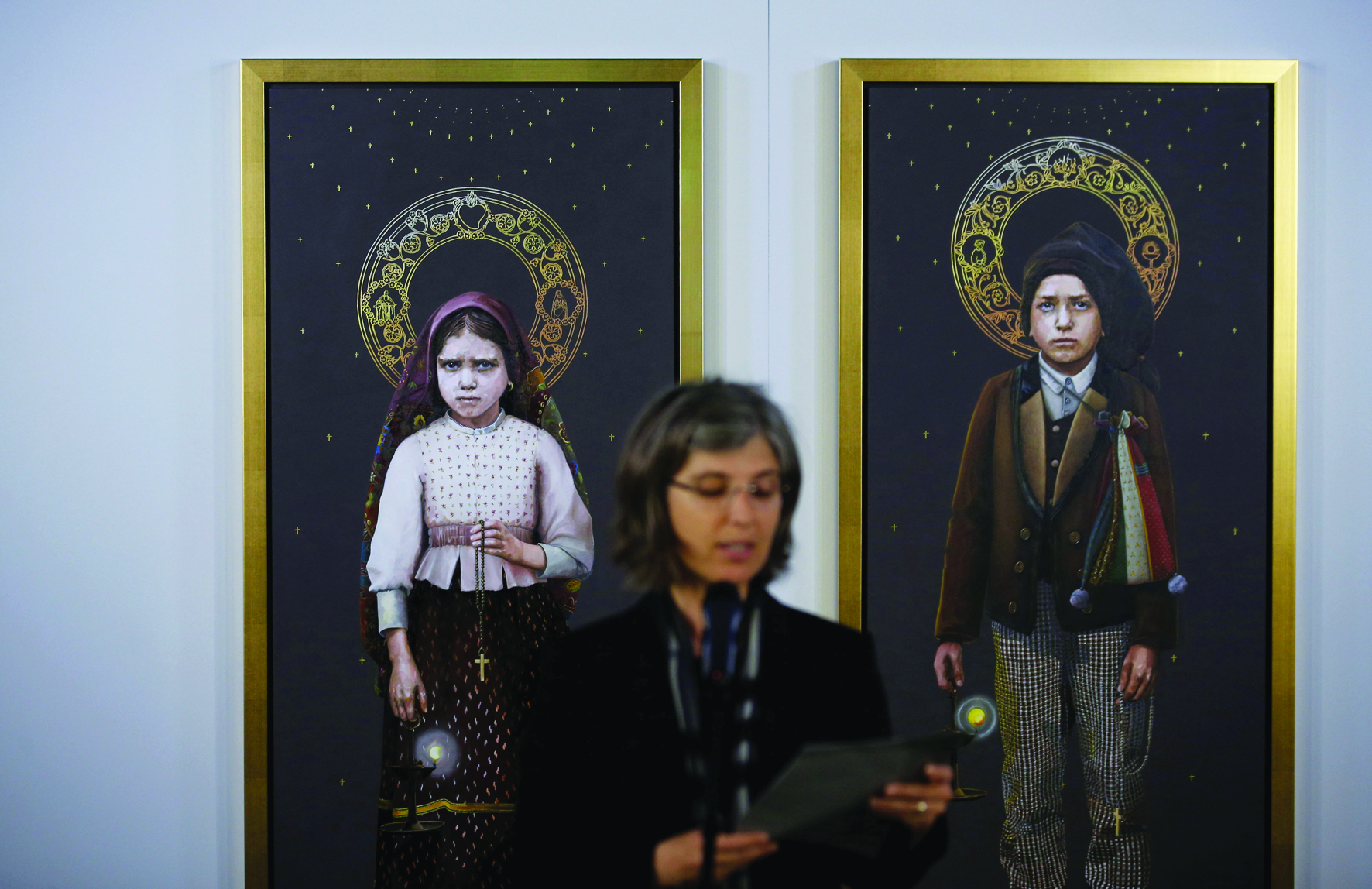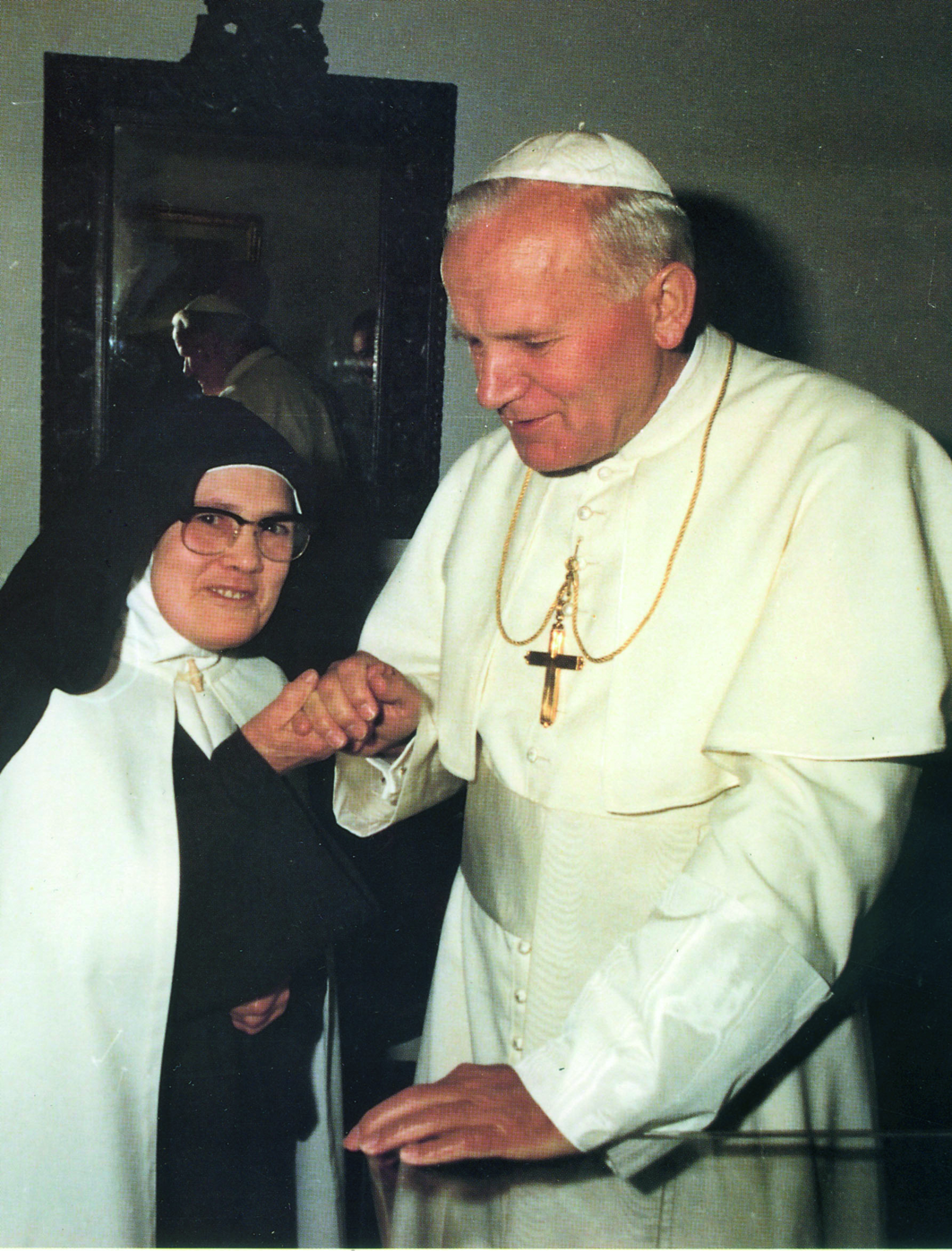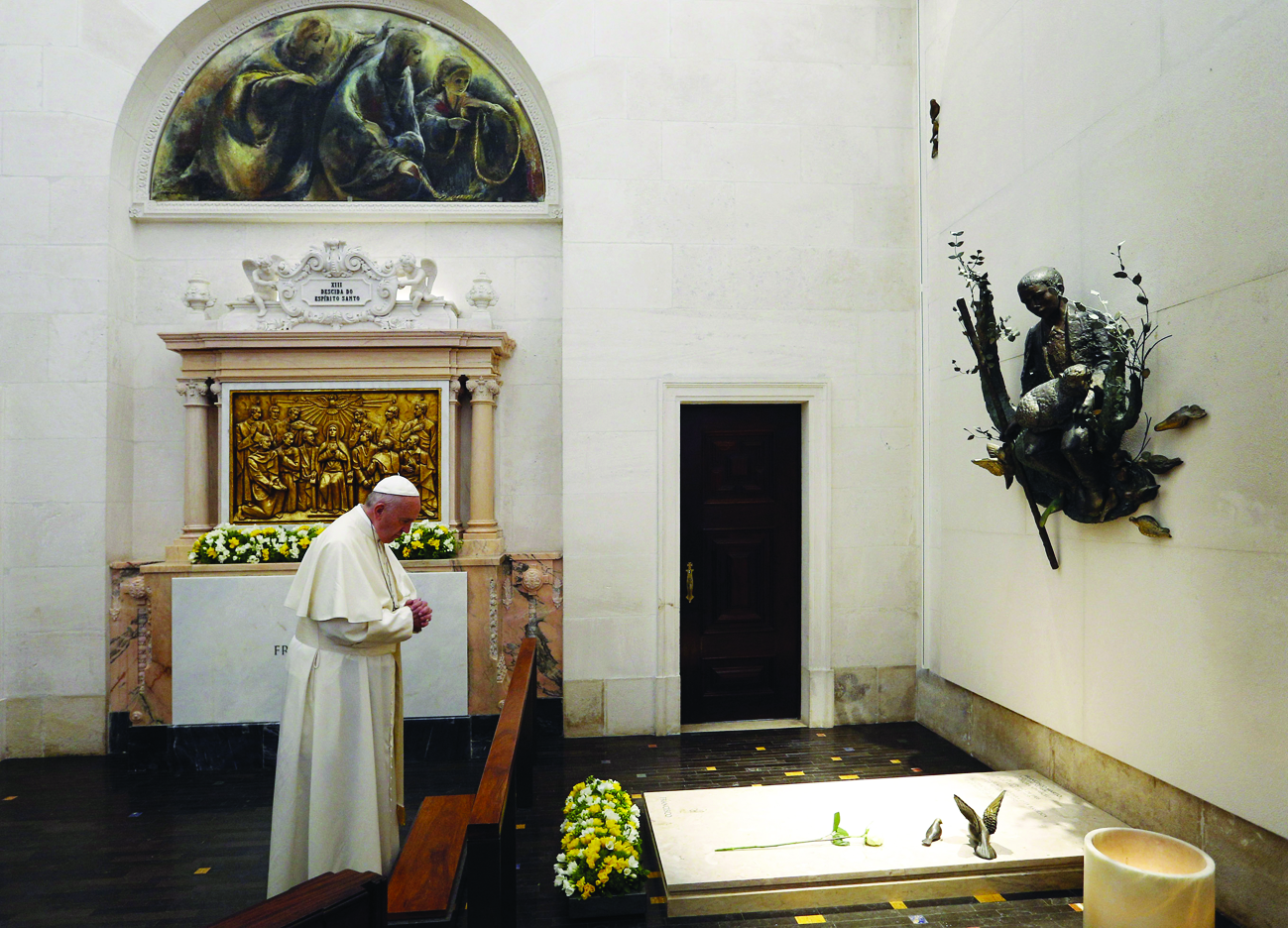An Interview with Postulator for the Causes of the Child-Saints: Francisco and Jacinta Marto of Fatima
By Barbara Middleton for Inside the Vatican
Francisco de Jesus Marto and Jacinta de Jesus Marto were siblings from Aljustrel, a small hamlet near Fátima, Portugal, who with their cousin Lúcia dos Santos witnessed three apparitions of the Angel of Peace in 1916 and several apparitions of the Blessed Virgin Mary at Cova da Iria in 1917. Pope Francis canonized Francisco and Jacinta on May 13, 2017, the 100th anniversary of the first apparition of Our Lady of Fatima. Jacinta is the youngest saint to have not died a martyr’s death. ITV correspondent Barbara Middleton interviewed the postulator for their cause, Sr. Angela Coelho.

The three shepherd children: Francisco,Lucia and Jacinta, witnesses of the several apparitions of the Blessed Virgin Mary at Fatima, Portugal, from May to October in 1917
Barbara Middleton: How did you first become interested in Fatima?
Since I was a child, the devotion to our Lady and to the Message of Fatima always has been present in our family life, I think I can say that I have received it as heritance. However, as I grew up, this familiarity was transformed into a love, commitment and dedication relationship.
Is it true that you helped to establish a religious community dedicated to Fatima?
I know the “Alliance of Holy Mary” since my childhood. I keep the memory of a small, but very joyful and united, “family” of women nurtured by the same filial love to Our Lady and totally committed to the Message of Fatima. When I joined “Alliance of Holy Mary,” in 1995, we were not yet recognized by the Catholic Church as a Religious Congregation; we were a few sisters and everything was still germinating. So, I cooperated at the time we were fixing the identity, and the approval came for the “Alliance of Holy Mary” as a Religious Congregation by the Catholic Church.
How were you selected to be a postulator for the cause of Saints Jacinta and Francisco? And now sister M. Lucia.
As a consecrated woman, the message of Fatima and the shepherd children’s lives are part of my mission and of what I am as individual and, since very early in the “Alliance of Holy Mary,” I dedicated most of my activity to the apostolical work of giving talks on Fatima and the shepherd children’s way of sanctity.
In 2000 I met Fr. Luis Kondor, SVD. He was, at that time, the vice-postulator for Francisco and Jacinta Marto’s cause. I’m a medical doctor also, so I started to accompany him. Naturally, within the scope of the doctor-patient relationship, this love and dedication to Fatima was manifested and, in 2009, due to Fr. Kondor’s delicate state of health and advanced age, Antonio Marto, Bishop for the Leiria-Fatima Diocese, asked me to assume the cause.
When Fr. Molinari, SJ, died – he was the Roman postulator for the cause – I was asked to assume also his role.
In 2014, in Rome, I had the chance to meet Fr. Romano Gambalunga, OCD, the general postulator for the Order of Mount Carmel. By that time, he asked me to support the cause of Sr. Lucia, assuming the role of vice-postulator.
Is it true that there were some who were skeptical about the cause of Jacinta and Francisco because they were children and they did not die as martyrs?

Paintings of Blessed Jacinta Marto and Blessed Francisco Marto are presented by Sr. Angela Coelho, the postulator, during a May 8, 2017 news conference in Fatima, Portugal
In fact, the cause of Francisco and Jacinta Marto’s beatification and canonization is an historical landmark in the life of the Church, because they are the first canonized children who didn’t suffer martyrdom.
Maybe it’s not about skepticism; it was typical of the mentality of that time. Until 1981, the fact of considering that children do not have sufficient maturity to practice the virtues in heroic degree was a major obstacle to the canonization of children who were non-martyrs, which would include Francisco and Jacinta Marto. Francisco and Jacinta’s cause challenged the Church to question this rule. John Paul II, in that same year, asked to CCS for an opinion on this fact. An interdisciplinary committee met to study the issue and the Holy Father established that the Catholic Church recognizes holiness in children.
What were the most remarkable indications of the heroic sanctity of Saints Jacinta and Francisco?
For Francisco Marto the central attitude is the deep contemplation of Jesus, seeking to console Him for all the offenses, and the imitation of His silent and hidden prayer. In the silence of Eucharistic adoration, He whom Francisco called “Hidden Jesus” nurtured a deep friendship made of his abandonment, and his presence in the many hours he spent in front of the tabernacle, in the parish church. Francisco preferred to pray all alone, for in this inhabited solitude, he was willing to think about God, how He was sad, consoling and giving Him joy.
Jacinta stood out in a generous Christlike imitation as the suffering servant abandoned at the Cross. In fact, the central attitude in Jacinta’s holiness is the profound compassion for “poor sinners.” “Wounded” by the love for Hidden Jesus in the Eucharist, and compassion for sinners, for those who suffer the most and for the Holy Father, the center of her prayers and sacrifices, she was willing to “only put in the hearts of all, the fire that was burning” within her heart, and that made her “love the Hearts of Jesus and Mary so very much.”
What do the lives of Saints Jacinta and Francisco teach us about holiness?
These two saints teach us a lot about holiness. However, I would like to emphasize that the most important thing is that holiness must be understood within the experience of a loving relationship that God establishes with each child that He loves. It was because they understood each other as deeply loved by God, in that light that Our Lady put in their hearts – that was God – the saints Francisco and Jacinta Marto let themselves be transformed into the image of Jesus’ Heart by the heavenly Mother. Therefore, holiness is giving life itself as a response to God in loving freedom, willing profoundly to correspond to divine love.
Do the apparitions at Fatima teach us about the role of the Blessed Virgin Mary in the life of the Church?

John Paul II with Sr. Lucy of Fatima during their first encounter on May 13, 1982
Of course. The Dogmatic Constitution Lumen Gentium, no. 62, states that Our Lady, after “taken up to Heaven,” did not lay aside Her “salvific duty”; instead, Mary’s maternity in the economy of salvation lasts without intermission. In Fatima, this maternity duty of Mary, that always comes to us, stands out. By the response of each believer to the maternal requests of Our Lady for conversion, prayer, reparation and consecration, humanity allows itself to be involved by a spiritual itinerary – “to Jesus through Mary” – within an experience of God’s salvific love for humanity.
Why are the apparitions at Fatima still important for the life of the Church?
The third part of the secret revealed by Our Lady on the apparition of 13th of July manifests the message of hope that Fatima is for the whole Church. Fatima points to the meaning of life, animated by the love for Jesus, for the benefit and unity of the ecclesial body. Our Lady’s requests for prayer and sacrifice go towards giving life an ecclesial dimension, and which fits into a much broader perspective of God’s love for the “cities in ruins.” Therefore, Fatima is, most of all, a call for the fidelity of the Church to the vocation to be a sign of hope, alive, maternal and incarnated, for the world.
What did Mary mean when she said: “In the end my Immaculate Heart will triumph?”
The greatest moments in the history of salvation in Jesus, the Incarnation and Resurrection, happened in a hidden way, in solitude, away from the gaze of human knowledge. In my opinion, the triumph of the Immaculate Heart of Mary takes part in the same divine logic. It’s not going to be an ostentatious event in a specific moment in history, but, as Franco Manzi, an Italian biblist, says, her triumph is fulfilled thanks to imitation and “repeated acts of consecration of many Christians to the Immaculate Heart of Mary. In fact, the triumph of the Heart of Mary happens whenever, responding to the requests for prayer, reparation and consecration, our hearts are opened to the action of the Holy Spirit and He “will shape the hearts of these and those of so many other believers to the heart of Christ.”
 Do you know how the cause for the beatification of Sister Lucia is progressing?
Do you know how the cause for the beatification of Sister Lucia is progressing?
The cause for the beatification of Sister Lucia is developing in a very positive way. At this moment, we are in the so-called Roman phase, in the stage of writing the Positio on her virtues. Therefore, as soon as we finish it, we will go on to the other phases of the process.
By the grace of God, I attended the funeral of Sister M. Lucia. Cardinal Bertone was the main celebrant. Did you attend the funeral?
Unfortunately, I didn’t have the opportunity to attend Sister Lucia’s funeral, but it was a remarkable moment in the history of the Portuguese and universal Church. We can say that Sister Lucia is a very important figure for the twentieth century’s history. After her death, the Portuguese government decreed a day of national mourning: that is only dictated on the occasion of death of people that have had a significant role for the nation.
St. Francisco died (of influenza) at home in his bed. Can you tell me something about his death?
Francisco fell ill in October of 1918 with the Spanish flu. According to the testimonies, he passed away by 10pm on the 4th of April, 1919. Since that moment, Jesus ceased to be “hidden”; He made Himself totally visible to him.
Fully transformed in Jesus, that he so loved, Francisco Marto’s only thoughts, before he passed away, were about the final and everlasting encounter with Jesus. Therefore, once he said to Lucia that he might forget to ask Him for the intentions that she was entrusting him because, he said “I’m afraid to forget when I see Our Lord. And then, more than anything else I want to console Him.”
St. Francisco saw himself in the light of God. Can you explain about the light?
In fact, the light is one of the elements present in both the Angel of Peace or Our Lady’s apparitions. The “Lady brighter than the sun,” surrounded by light and full of God that, as Sr Lucia wrote, “was that Light,” appears as the mediator of that light of God’s that reveals the Mystery of the Trinity and leads and introduces us to communion with God.
St. Francisco was particularly sensitive to that Light; he once said to Lucia: “I loved seeing Our Lord, but I loved still more seeing Him in that light where we were with Him as well.” The Light is the manifestation of a God that is close, within the innermost depths of the human being, and that reaches each of us, leading to transformation. In the Light that is God, one can see himself in Him, more clearly than in the best of mirrors. That happened with little Francisco and, from that day on, his conversion to the merciful love of God grew until he gave whole life for Jesus and died within that Light.
It is reported that Jacinta was in a room behind Francisco but did not permit herself to visit him as an offering/penance for Poor Souls. Did this happen?
Love is creative, and these children’s love responded with their own creativity to the Angel’s call since the moment he asked them to offer sacrifices of everything they could. Jacinta, as Lucia used to say, was insatiable about offering sacrifices; therefore, she wouldn’t miss an opportunity to offer sacrifices. Then, we can understand even the sacrifices that could seem more insignificant. Lucia said that, many times, Jacinta wanted to visit Francisco in his bedroom, but she did not, so she could offer that sacrifice.
I would like to see Jacinta made Patron Saint of the Popes. Jacinta had a vision of a Holy Father weeping. What are your thoughts on that?
Jacinta’s heart was touched by the suffering of the whole of humanity and, most of all, touched by the suffering of the Holy Father. After seeing the Holy Father suffering, she never ceased to offer herself and to pray for him. When we think about Jacinta, it’s easy to think about Moses in the Old Testament when the prophet held up his arms so Israel could prevail against the enemy; in a similar way, Jacinta held up her prayers and sacrifices to bring some relief to the Holy Father’s suffering. In fact, as Jacinta supported the others in their suffering, her heart widened.
On February 13, 2005, John Paul II sent a fax to Sister M. Lucia of Jesus ..a few hours before her death. He ended his message by imparting his blessing to her. Can you share with us the final words of Sister M. Lucia?

Pope Francis prays at the tomb of St. Francisco Marto during his visit to Fatima on May 13, 2017. (Grzegorz Galazka photo)Opposite, page from Ilustração Portuguesa, 29 October 1917,showing the people looking at the sun as it danced in the sky during the Fátima apparitions on October 13, 2017
One of Sister Lucia’s relevant characteristics was her profound communion with the Church. So, it is meaningful to state that her last words were directed to the Pope. At her last moment, she offered the suffering she was going through for the Holy Father.
The dedication of a whole life by the offering of herself can t be thrown to oblivion or erased. Therefore, her lifetime speaks loudly of what filled the heart of Sr. Lucia.
What brought the little saints (Jacinta and Francisco) to the altars in Heaven?
Saints Francisco and Jacinta’s biography reveals to us a life marked by a self fiat to God’s will.
Both answered Jesus’ invitation to share His chalice that they drank from in the third apparition of the angel, so, they turned their experience on earth into a heavenly experience.
The Kingdom of God belongs to the little ones and these two little but great saints were witnesses of this Kingdom until the end with their creative fidelity to God that revealed Himself to them as love. What else could raise someone to the altars but love?
Are we living in the times of the “Third Secret of Fatima?”
In Joseph Ratzinger’s (Pope Benedict XVI) theological commentary on the secret of Fatima, regarding the third part of the secret, we are offered an attempt at an interpretation of the symbolic meaning of the various elements that constitute the Via Crucis, in the third part of the secret. The steep mountain and the city in ruins appears to us as the place of human history, a place of destruction but also a place of creativity, where good and evil intersect, but the place where Jesus’s cross is lifted up as the goal and fountain of our strength for our salvation.
This place of human history symbolically represented in the third part of the secret is history that continues, the history of redemption, also marked by sin, and from it emerges the paradox of the crucified but victorious Christ.
We live in times of the third part of the secret if we are aware that also we are climbing the “steep mountain” and we walk through the “ruins of our cities” with our gaze placed on Christ.
When Pope Francis (on March 27, 2020) presided over prayers for humanity at an empty St. Peter’s Square, it reminded me of the vision of St. Jacinta. Your thoughts?
These times of pandemic we are living through remind us that, precisely 100 years ago, Jacinta Marto also would suffer and die in similar circumstances. St. Jacinta Marto is a gift to us, a beautiful witness of how we can offer ourselves for the benefit of others.
Seeing Pope Francis in an empty St. Peter’s Square, praying for everyone, reminded me of little Jacinta who, as Lucia used to say, never forgot to pray for the intentions of those who asked her.
Impressed by the Holy Father’s suffering, St. Jacinta Marto always remembered him in her prayers and sacrifices. Following Pope Francis’ example of praying for the whole of humanity, it would be good if we, like St. Jacinta, never forget his intentions and pray for those who most suffer because of this pandemic.






Facebook Comments